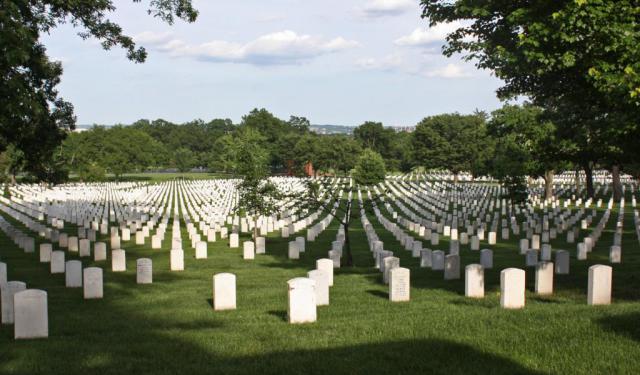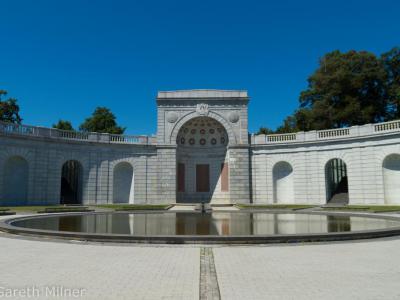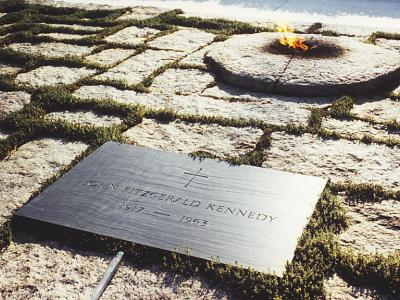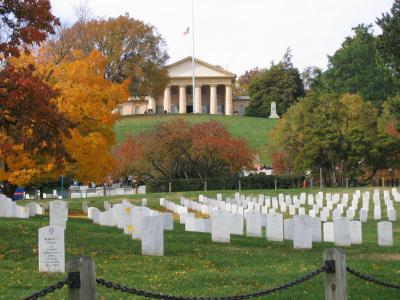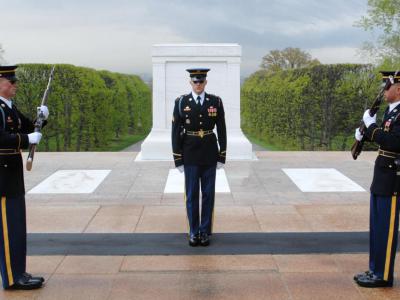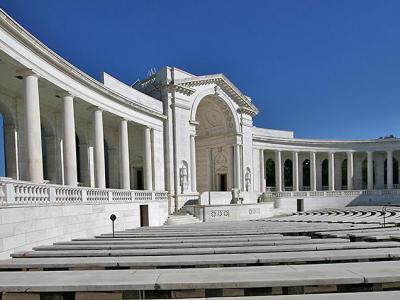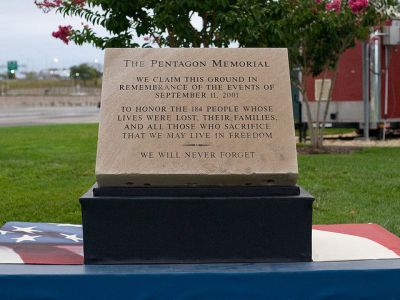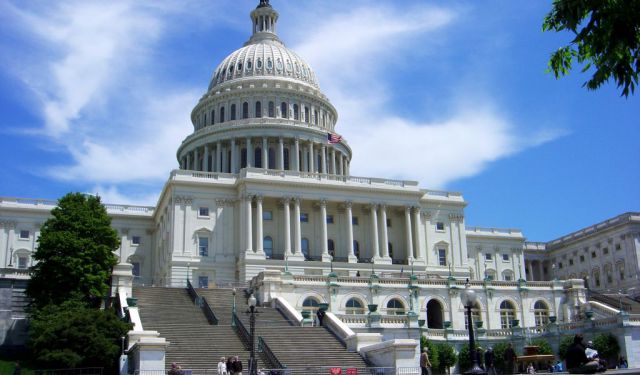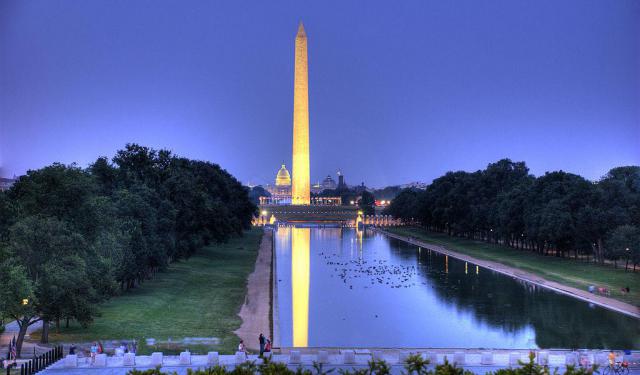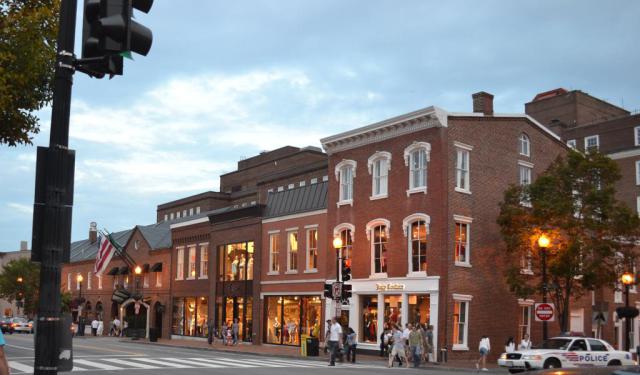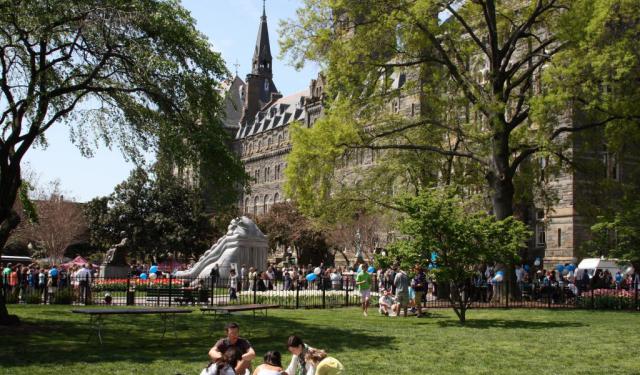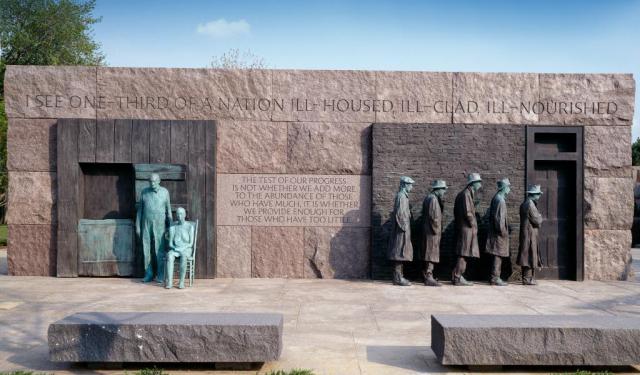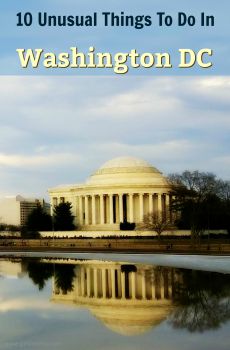Arlington National Cemetery Tour (Self Guided), Washington D.C.
"The legacy of heroes is the memory of a great name and the inheritance of a great example," a distinguished politician of the 19th century said once.
The historic military necropolis – the Arlington National Cemetery in Arlington, Virginia – is the final resting place for many of America's heroes, whose willingness to sacrifice for their country has earned them the nation's lasting gratitude. The cemetery was established during the American Civil War, in 1864, and has since become a revered national shrine and an important symbol of honor, sacrifice, and remembrance. Situated just across the Potomac River from Washington, D.C., it spans some 624 acres of rolling hills, tree-lined avenues, and well-manicured lawns.
One of Arlington's most iconic features is the Tomb of the Unknown Soldier, honoring the unidentified servicemen fallen during World War I, World War II, and the Korean and Vietnam wars. "Here rests in honored glory an American soldier known but to God," says the inscription.
The Arlington cemetery is also the burial site for many notable individuals, such as President John F. Kennedy, as well as groups such as the crews of the Space Shuttles Challenger and Columbia, and the 9/11 Pentagon attack victims.
"The brave die never, though they sleep in dust: their courage nerves a thousand living men." If you wish to pay a solemn tribute to the men and women who served and died for America, take this self-guided walk.
The historic military necropolis – the Arlington National Cemetery in Arlington, Virginia – is the final resting place for many of America's heroes, whose willingness to sacrifice for their country has earned them the nation's lasting gratitude. The cemetery was established during the American Civil War, in 1864, and has since become a revered national shrine and an important symbol of honor, sacrifice, and remembrance. Situated just across the Potomac River from Washington, D.C., it spans some 624 acres of rolling hills, tree-lined avenues, and well-manicured lawns.
One of Arlington's most iconic features is the Tomb of the Unknown Soldier, honoring the unidentified servicemen fallen during World War I, World War II, and the Korean and Vietnam wars. "Here rests in honored glory an American soldier known but to God," says the inscription.
The Arlington cemetery is also the burial site for many notable individuals, such as President John F. Kennedy, as well as groups such as the crews of the Space Shuttles Challenger and Columbia, and the 9/11 Pentagon attack victims.
"The brave die never, though they sleep in dust: their courage nerves a thousand living men." If you wish to pay a solemn tribute to the men and women who served and died for America, take this self-guided walk.
How it works: Download the app "GPSmyCity: Walks in 1K+ Cities" from Apple App Store or Google Play Store to your mobile phone or tablet. The app turns your mobile device into a personal tour guide and its built-in GPS navigation functions guide you from one tour stop to next. The app works offline, so no data plan is needed when traveling abroad.
Arlington National Cemetery Tour Map
Guide Name: Arlington National Cemetery Tour
Guide Location: USA » Washington D.C. (See other walking tours in Washington D.C.)
Guide Type: Self-guided Walking Tour (Sightseeing)
# of Attractions: 6
Tour Duration: 2 Hour(s)
Travel Distance: 4.1 Km or 2.5 Miles
Author: irene
Sight(s) Featured in This Guide:
Guide Location: USA » Washington D.C. (See other walking tours in Washington D.C.)
Guide Type: Self-guided Walking Tour (Sightseeing)
# of Attractions: 6
Tour Duration: 2 Hour(s)
Travel Distance: 4.1 Km or 2.5 Miles
Author: irene
Sight(s) Featured in This Guide:
- Women in Military Service for America Memorial
- John F. Kennedy Gravesite Eternal Flame
- Arlington House, The Robert E. Lee Memorial
- Tomb of the Unknown Soldier (Arlington)
- Arlington Memorial Amphitheater
- Pentagon Memorial
1) Women in Military Service for America Memorial
The Women in Military Service for America Memorial (WIMSA), commonly known as the Women's Memorial, is a significant national monument established by the U.S. federal government to honor women who have served alongside the United States Armed Forces since the American Revolution up to the present day.
Situated at the western terminus of Memorial Avenue, at the primary entrance to Arlington National Cemetery known as the Memorial Gate, this structure was originally named the Hemicycle and was constructed in 1932. In 1988, it was designated as the location for WIMSA, which was formally inaugurated in 1997.
The memorial seamlessly combines Neoclassical and Modern architectural styles. It preserves the Hemicycle's original structure and adds a highly regarded skylight on its terrace. This skylight serves not only as a tribute to servicewomen but also as a connection to the memorial below. The memorial also houses a visitor center that features rotating special exhibits.
While women were not officially integrated into the U.S. military until the 20th century, WIMSA pays homage to all women who have displayed unwavering patriotism and courage, becoming an indispensable part of America's national identity. It ensures that their contributions to the country are forever etched in our memory.
The on-site Education Center offers a historical perspective on the women who have defended America throughout its history, encompassing those who served in various capacities in the 20th and 21st centuries, as well as their predecessors during earlier times of crisis. Photographs of female veterans from their service years alongside their current lives provide a powerful source of inspiration. This memorial stands as a symbol of the nation's gratitude.
Situated at the western terminus of Memorial Avenue, at the primary entrance to Arlington National Cemetery known as the Memorial Gate, this structure was originally named the Hemicycle and was constructed in 1932. In 1988, it was designated as the location for WIMSA, which was formally inaugurated in 1997.
The memorial seamlessly combines Neoclassical and Modern architectural styles. It preserves the Hemicycle's original structure and adds a highly regarded skylight on its terrace. This skylight serves not only as a tribute to servicewomen but also as a connection to the memorial below. The memorial also houses a visitor center that features rotating special exhibits.
While women were not officially integrated into the U.S. military until the 20th century, WIMSA pays homage to all women who have displayed unwavering patriotism and courage, becoming an indispensable part of America's national identity. It ensures that their contributions to the country are forever etched in our memory.
The on-site Education Center offers a historical perspective on the women who have defended America throughout its history, encompassing those who served in various capacities in the 20th and 21st centuries, as well as their predecessors during earlier times of crisis. Photographs of female veterans from their service years alongside their current lives provide a powerful source of inspiration. This memorial stands as a symbol of the nation's gratitude.
2) John F. Kennedy Gravesite Eternal Flame
The John F. Kennedy Eternal Flame is a memorial dedicated to the memory of the slain United States President John F. Kennedy. It's located at his gravesite at Arlington National Cemetery in Virginia. This memorial, which stands as a permanent tribute, replaced a temporary grave and an everlasting flame that were used during Kennedy's state funeral on November 25, 1963, just three days after his tragic assassination.
The design of this site was crafted by the architect John Carl Warnecke, who was a close friend of Kennedy. The official consecration of the permanent John F. Kennedy Eternal Flame gravesite took place on March 15, 1967, when it was opened to the public.
The construction involved using twenty tons of steel for the terrace and pouring 280 tons of concrete to create the grave vaults and the site for the eternal flame. The inscriptions on the wall, chosen by Jacqueline Kennedy with the assistance of Kennedy's speechwriter Ted Sorensen, were selected by November 1965. These inscriptions were taken from Kennedy's inaugural address in 1961. The quotations were engraved onto seven granite blocks using Roman majuscule lettering.
Immediately following Kennedy's burial, the gravesite and the Eternal Flame became a place of pilgrimage, drawing approximately 50,000 visitors per day. In its first three years, more than 16 million people paid their respects at this sacred site.
Kennedy’s two sons, John F. Kennedy Jr. and Patrick Bouvier Kennedy, as well as Jacqueline herself, are also buried in the same plot alongside the president.
The design of this site was crafted by the architect John Carl Warnecke, who was a close friend of Kennedy. The official consecration of the permanent John F. Kennedy Eternal Flame gravesite took place on March 15, 1967, when it was opened to the public.
The construction involved using twenty tons of steel for the terrace and pouring 280 tons of concrete to create the grave vaults and the site for the eternal flame. The inscriptions on the wall, chosen by Jacqueline Kennedy with the assistance of Kennedy's speechwriter Ted Sorensen, were selected by November 1965. These inscriptions were taken from Kennedy's inaugural address in 1961. The quotations were engraved onto seven granite blocks using Roman majuscule lettering.
Immediately following Kennedy's burial, the gravesite and the Eternal Flame became a place of pilgrimage, drawing approximately 50,000 visitors per day. In its first three years, more than 16 million people paid their respects at this sacred site.
Kennedy’s two sons, John F. Kennedy Jr. and Patrick Bouvier Kennedy, as well as Jacqueline herself, are also buried in the same plot alongside the president.
3) Arlington House, The Robert E. Lee Memorial
Arlington House, formerly known as the Custis-Lee Mansion, is a Greek revival-style residence with a rich historical background. It once served as the home of the renowned Confederate Army General Robert E. Lee before the Civil War. Throughout its history, this house had various roles, including being a plantation estate where 63 slaves lived, serving as a military headquarters, and becoming a community for emancipated slaves. However, in 1864, the federal government took control of it to establish Arlington National Cemetery as a burial ground for Civil War soldiers. This action was partly aimed at preventing General Lee from ever returning to his former home.
Perched on a hill overlooking the cemetery, Arlington House was later restored and designated as a national memorial in honor of General Lee. While the United States Department of the Army manages Arlington National Cemetery, Arlington House falls under the administration of the National Park Service, a division of the United States Department of the Interior.
The Robert E. Lee Memorial is open for public tours daily. Aside from offering breathtaking views of the Potomac River and the National Mall in Washington, D.C., especially enchanting during April when cherry trees are in full bloom, there are numerous compelling reasons to visit this historic site within Arlington National Cemetery. This house commemorates General Lee for specific accomplishments, including his efforts in promoting peace and national reunification after the Civil War. More broadly, it serves as a place for reflection and study of some of the most challenging aspects of American history, such as military service, sacrifice, citizenship, duty, loyalty, slavery, and freedom.
Openining Hours:
Monday - Sunday: 9:30 am - 4:30 pm.
Perched on a hill overlooking the cemetery, Arlington House was later restored and designated as a national memorial in honor of General Lee. While the United States Department of the Army manages Arlington National Cemetery, Arlington House falls under the administration of the National Park Service, a division of the United States Department of the Interior.
The Robert E. Lee Memorial is open for public tours daily. Aside from offering breathtaking views of the Potomac River and the National Mall in Washington, D.C., especially enchanting during April when cherry trees are in full bloom, there are numerous compelling reasons to visit this historic site within Arlington National Cemetery. This house commemorates General Lee for specific accomplishments, including his efforts in promoting peace and national reunification after the Civil War. More broadly, it serves as a place for reflection and study of some of the most challenging aspects of American history, such as military service, sacrifice, citizenship, duty, loyalty, slavery, and freedom.
Openining Hours:
Monday - Sunday: 9:30 am - 4:30 pm.
4) Tomb of the Unknown Soldier (Arlington)
The Tomb of the Unknown Soldier, also known as the Tomb of the Unknowns, serves as a memorial to American military personnel who bravely fought and lost their lives in World Wars I and II, the Korean War, and the Vietnam War. These individuals remain unidentified.
Constructed in 1921, this tomb is a prominent monument situated on a hill overlooking Washington, D.C. It comprises a large white sarcophagus containing the remains of these unidentified soldiers. Notably, the "Unknown" from World War I was honored with the Medal of Honor, the Victoria Cross, and various other prestigious foreign service awards. Similarly, the American "Unknowns" interred here were posthumously awarded the Medal of Honor, presented by U.S. Presidents who attended their funerals.
The tomb is under constant vigilance, with Tomb Guard sentinels from the distinguished 3rd U.S. Infantry Regiment standing watch 24 hours a day, 365 days a year. The Changing of the Guard ceremony is a solemn and intricate ritual. During this ceremony, a sentinel seamlessly takes over guard duty from their predecessor, involving a special march and salute. This ceremony occurs hourly from October to March and every half-hour from April to September.
Constructed in 1921, this tomb is a prominent monument situated on a hill overlooking Washington, D.C. It comprises a large white sarcophagus containing the remains of these unidentified soldiers. Notably, the "Unknown" from World War I was honored with the Medal of Honor, the Victoria Cross, and various other prestigious foreign service awards. Similarly, the American "Unknowns" interred here were posthumously awarded the Medal of Honor, presented by U.S. Presidents who attended their funerals.
The tomb is under constant vigilance, with Tomb Guard sentinels from the distinguished 3rd U.S. Infantry Regiment standing watch 24 hours a day, 365 days a year. The Changing of the Guard ceremony is a solemn and intricate ritual. During this ceremony, a sentinel seamlessly takes over guard duty from their predecessor, involving a special march and salute. This ceremony occurs hourly from October to March and every half-hour from April to September.
5) Arlington Memorial Amphitheater
Memorial Amphitheater in Arlington National Cemetery replaced an older wooden amphitheater in 1913. It now serves as an open-air venue with an amphitheater, exhibition hall, and chapel. It's located amidst various monuments and landscape elements, like the USS Maine Mast Memorial to the west, the Spanish–American War Memorial to the south, and a formal Italian-style garden to the east.
On October 13, 1915, President Woodrow Wilson laid the cornerstone for a new amphitheater, which held a copper box with 15 significant items, such as the US Constitution, Declaration of Independence, Bible, American flag, coins, stamps, Congressional directory, DC telephone book, President Wilson's photo, and Arlington National Cemetery mementos.
The amphitheater itself was predominantly constructed using Imperial Danby marble sourced from Vermont and Botticino stone imported from Italy. It was officially dedicated on May 15, 1920, and underwent several renovations throughout the years, including those in 1956, 1974, 1995–1996, and 2012.
This venue hosts regular memorial services, including those on Memorial Day and Veterans Day, sponsored by the U.S. Army Military District of Washington. These events often feature the President or Vice President. Since 1931, it's been the site of the popular annual Easter sunrise service, initially organized by the Knights Templar and attended by President Herbert Hoover. Additionally, many military organizations hold annual memorial services here, with nearly 5,000 attendees each year.
Memorial Amphitheater hosts state funerals for distinguished Americans, including General John J. "Black Jack" Pershing, Secretary of Defense James Forrestal, and Rear Admiral Richard E. Byrd. It's also the resting place for an unknown Vietnam War soldier (1984), 30 unidentified 9/11 Pentagon attack victims (2002), and the last WWI American veteran (2011).
On October 13, 1915, President Woodrow Wilson laid the cornerstone for a new amphitheater, which held a copper box with 15 significant items, such as the US Constitution, Declaration of Independence, Bible, American flag, coins, stamps, Congressional directory, DC telephone book, President Wilson's photo, and Arlington National Cemetery mementos.
The amphitheater itself was predominantly constructed using Imperial Danby marble sourced from Vermont and Botticino stone imported from Italy. It was officially dedicated on May 15, 1920, and underwent several renovations throughout the years, including those in 1956, 1974, 1995–1996, and 2012.
This venue hosts regular memorial services, including those on Memorial Day and Veterans Day, sponsored by the U.S. Army Military District of Washington. These events often feature the President or Vice President. Since 1931, it's been the site of the popular annual Easter sunrise service, initially organized by the Knights Templar and attended by President Herbert Hoover. Additionally, many military organizations hold annual memorial services here, with nearly 5,000 attendees each year.
Memorial Amphitheater hosts state funerals for distinguished Americans, including General John J. "Black Jack" Pershing, Secretary of Defense James Forrestal, and Rear Admiral Richard E. Byrd. It's also the resting place for an unknown Vietnam War soldier (1984), 30 unidentified 9/11 Pentagon attack victims (2002), and the last WWI American veteran (2011).
6) Pentagon Memorial
The Victims of the Terrorist Attack on the Pentagon Memorial serves as a tribute to the 184 individuals who lost their lives on American Airlines Flight 77 and within the Pentagon building on September 11, 2001, when it was targeted by al-Qaeda terrorists.
This memorial site is located at Arlington National Cemetery and includes a 4.5-foot (1.4-meter) tall granite marker in the shape of a pentagon. On the upper part of this marker, the words "Victims of Terrorist Attack on the Pentagon September 11, 2001" are engraved. Five aluminum plaques, painted black, bear the names of the 184 victims of the terrorist attack. Each plaque corresponds to one side of the marker. Notably, the names of those who were on Flight 77 are marked with a diamond symbol in front of their name, while individuals for whom no remains could be identified are indicated with a star symbol in front of their name. The memorial also features a pentagonal base extending approximately 5 inches (13 cm) outward and downward from the main body of the monument.
The memorial site occupies an area of 1.93 acres (0.78 hectares) and was designed by John C. Metzler, Jr., the Superintendent of Arlington National Cemetery. It was commissioned by the United States Department of Veterans Affairs on September 12, 2002.
This memorial site is located at Arlington National Cemetery and includes a 4.5-foot (1.4-meter) tall granite marker in the shape of a pentagon. On the upper part of this marker, the words "Victims of Terrorist Attack on the Pentagon September 11, 2001" are engraved. Five aluminum plaques, painted black, bear the names of the 184 victims of the terrorist attack. Each plaque corresponds to one side of the marker. Notably, the names of those who were on Flight 77 are marked with a diamond symbol in front of their name, while individuals for whom no remains could be identified are indicated with a star symbol in front of their name. The memorial also features a pentagonal base extending approximately 5 inches (13 cm) outward and downward from the main body of the monument.
The memorial site occupies an area of 1.93 acres (0.78 hectares) and was designed by John C. Metzler, Jr., the Superintendent of Arlington National Cemetery. It was commissioned by the United States Department of Veterans Affairs on September 12, 2002.
Walking Tours in Washington D.C., USA
Create Your Own Walk in Washington D.C.
Creating your own self-guided walk in Washington D.C. is easy and fun. Choose the city attractions that you want to see and a walk route map will be created just for you. You can even set your hotel as the start point of the walk.
Federal Buildings Walking Tour
The capital of the United States is home to several notable federal buildings that hold significant historical, architectural, and governmental value.
Among the stately “emblems of authority” in Washington D.C. perhaps the most prominent is the official residence and workplace of the President of the United States – The White House. This resplendent mansion at 1600 Pennsylvania Avenue... view more
Tour Duration: 2 Hour(s)
Travel Distance: 4.9 Km or 3 Miles
Among the stately “emblems of authority” in Washington D.C. perhaps the most prominent is the official residence and workplace of the President of the United States – The White House. This resplendent mansion at 1600 Pennsylvania Avenue... view more
Tour Duration: 2 Hour(s)
Travel Distance: 4.9 Km or 3 Miles
Washington D.C. Introduction Walking Tour
Washington, D.C., formally the District of Columbia or simply The District, is the capital of the United States and, in many senses, America’s front yard. After the American Revolution, the need for the newly independent nation's federal government to have authority over a capital city and not rely on any state for its maintenance and safety, came in the wake of the Pennsylvania Mutiny of... view more
Tour Duration: 2 Hour(s)
Travel Distance: 5.2 Km or 3.2 Miles
Tour Duration: 2 Hour(s)
Travel Distance: 5.2 Km or 3.2 Miles
Georgetown Walking Tour
Georgetown is a historic neighborhood situated in the northwest quadrant of Washington, DC. Despite its proximity to downtown, this former port area has preserved much of its distinct character. In Georgetown, "old-world charm meets modern allure," they say. Those poetically inclined tend to compare it to "a tapestry of cobblestone dreams and timeless grace."
The... view more
Tour Duration: 2 Hour(s)
Travel Distance: 3.9 Km or 2.4 Miles
The... view more
Tour Duration: 2 Hour(s)
Travel Distance: 3.9 Km or 2.4 Miles
Georgetown University Walking Tour
Georgetown University, established in 1789, is America's oldest Catholic and Jesuit institution. Spanning four campuses in Washington, DC, its main undergraduate campus in Georgetown features fifty-four buildings across 104 acres.
With its Gothic and Georgian architecture, serene green spaces, and Jesuit traditions, the university promotes academic excellence and global engagement. For... view more
Tour Duration: 2 Hour(s)
Travel Distance: 2.1 Km or 1.3 Miles
With its Gothic and Georgian architecture, serene green spaces, and Jesuit traditions, the university promotes academic excellence and global engagement. For... view more
Tour Duration: 2 Hour(s)
Travel Distance: 2.1 Km or 1.3 Miles
DC Monuments and Memorials Walking Tour
"In the end, it's not the years in your life that count. It's the life in your years," goes the famous quote by Abraham Lincoln.
Indeed, those remembered in Washington, D.C. – the renowned statesmen, politicians, fallen soldiers, and other distinguished persons – had their years filled with life to the brim. What they left behind is a great legacy manifested in historic... view more
Tour Duration: 2 Hour(s)
Travel Distance: 3.6 Km or 2.2 Miles
Indeed, those remembered in Washington, D.C. – the renowned statesmen, politicians, fallen soldiers, and other distinguished persons – had their years filled with life to the brim. What they left behind is a great legacy manifested in historic... view more
Tour Duration: 2 Hour(s)
Travel Distance: 3.6 Km or 2.2 Miles
Useful Travel Guides for Planning Your Trip
10 Unusual Things to Do in Washington DC
You might be inclined to think that the capital of the United States consists solely of museums and monuments, but that couldn’t be further from the truth. As a local, I’ve found that there are so many more things to do in this city than just the main tourist highlights. Read on to learn 10 of...
7 Chocolate Destinations in Washington D.C.
Let’s be honest, you hear the words "Washington, D.C." and you think politics, history, museums, etc. You can’t take five steps in the city without being surrounded by history. As important as all that culture is, it’s also a bit overwhelming. Make it fun by exploring Washington,...
Traveler's Guide to Washington DC: 16 Souvenirs to Bring Home
The capital of the United States is an attraction in its own right and many things that have originated here or in the nearby areas are of great cultural and historic significance. To decide which of them can make for an ideal souvenir for you to bring home, check out the proposed list of local...
The Most Popular Cities
/ view all
